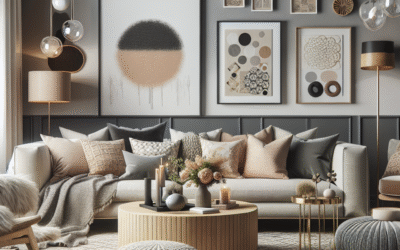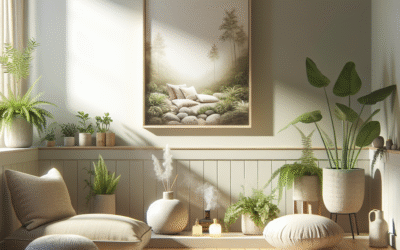
Mastering Bold Pattern Mixing: Unlocking the Secrets to a Cohesive Home Design
The Power of Patterns in Design
Patterns can breathe life into any space. They have that unique ability to evoke emotions, remind us of memories, and create atmospheres that resonate with who we are. When you think of bold patterns, what comes to mind? Maybe it’s an eye-catching geometric print or a vibrant floral design. Whatever it is, you know that patterns can do wonders for your home’s character.
Mixed patterns can animate a room, drawing the eye and inviting conversation. So, why do so many people hesitate to embrace this design dynamic? Often, the fear of clashing or overwhelming a space holds them back. Let’s unravel that and explore how you can master this art.
Understanding the Basics of Pattern Mixing
Here’s the thing: you don’t need to be a professional designer to mix patterns successfully. It’s more about understanding a few foundational principles.
-
Scale: Mixing different scales adds visual interest. Pairing a large-scale print with a smaller one creates balance. Think of it like dance partners; they shouldn’t overshadow each other but complement one another.
-
Color Harmony: Even though you might be mixing different patterns, keeping a cohesive color palette can tie the whole look together. This doesn’t mean everything has to match perfectly, but a few common hues will help.
-
Motif Variety: Use different motifs—like florals, stripes, or polka dots. This variety adds excitement but still feels cohesive when done thoughtfully.
Now, let’s break down these elements further.
Choosing a Color Palette
The color palette might just be the heart of your pattern-mixing journey. Consider this: a bold pattern might stand out splendidly, but what makes it “pop” even more is how it plays with its surroundings.
- Start With a Base: Choose a primary color you love. This will be your anchor throughout the space.
- Layer in Complementary Shades: Add two or three colors that complement your base. Think about the emotions these colors evoke—calm blues, vibrant reds, or earthy greens.
- Experiment with Neutrals: Neutrals can be lifesavers in pattern mixing. They serve as breathing space, allowing the bold patterns to shine without overwhelming the senses.
Scale and Proportion: The Dynamic Duo
You might wonder why scale is so crucial. It’s simple; it creates depth and interest. Imagine if everything in your room was the same size—it’d feel monotonous and flat, right?
- Big Meets Small: Pair a large floral curtain with a smaller geometric pillow on your couch. The big print draws the eye up, while the smaller adds dimension.
- Dare to Layer: Think about rugs. A large-patterned area rug layered over a smaller, solid-color one can make that cozy nook feel layered and interesting.
Oh, and let’s not forget texture! Mixing textures alongside patterns can elevate your design but be careful; too many textures can quickly turn the room chaotic.
Choosing Patterns That Complement Each Other
Here’s the fun part—selecting patterns! Too many contrasting styles can compete for attention, creating a confusing atmosphere. Instead, look for styles that play nicely together.
- Mixing Geometric with Organic: A geometric print pairs beautifully with an organic one, like florals or leaves. It’s like adding structure to spontaneity.
- Play with Similar Motifs: Consider patterns that feature similar shapes but vary in scale or layout. For example, pair stripes with a floral that features curved lines; they can dance together somehow.
But how do you know if they really complement each other? A simple trick is to hold samples next to one another. Trust your instincts—if it feels right, it probably is!
The Role of Texture in Pattern Mixing
Don’t overlook texture; it’s the unsung hero in pattern mixing! Different textures can add dimension and richness, making even the boldest patterns feel approachable.
Think of a plush velvet against a crisp linen. The marriage of textures plays off the other’s qualities, softening the overall look. So, consider pillows, throws, and decorative items when you’re pattern mixing.
Imagine sitting on a soft, textured chair, surrounded by floral prints and geometric shapes. It feels cozy and inviting, doesn’t it?
Setting the Right Tone for Each Space
Every room in your home has its own personality. The living room may call for bold statements, while the bedroom leans more toward serenity.
-
Living Spaces: Here, bring in vibrant patterns that reflect the energy of gatherings. Floral patterns might energize the room, while dynamic geometric shapes can spark interesting conversations.
-
Bedrooms: Opt for soothing patterns that evoke calmness. Soft florals or subtle stripes work wonders here, allowing for a peaceful retreat.
What’s your home saying about you? The patterns you choose can express your personality and intentions in each space.
Common Misconceptions and Mistakes
Let’s address the elephant in the room. Many folks think that mixing patterns requires an expert’s touch. Truth is, it’s more about confidence than skill.
- The One-Pattern Rule: You don’t have to stick to one pattern; rather, it’s all about balance.
- Avoiding Clashing Colors: Fear not! Clashing can sometimes work wonderfully if you already have a cohesive color palette.
Trust your gut—play around, and find out what resonates with your style!
Creating a Cohesive Look Throughout Your Home
If you’ve got the hang of mixing patterns in one room, why not sprinkle that skill throughout your entire home?
-
Create Flow with a Common Theme: Maybe each room has a different bold pattern, but they all echo a similar theme—like summer blooms or vibrant geometrics. This ties your spaces together seamlessly.
-
Connect Rooms with Color: If your living room showcases bright blues and yellows, you might mirror that palette in your kitchen or hallway. Each space can have its own flair, yet still maintain a cohesive story.
-
Use Accessories to Unify: A common denominator in your decorative accessories—think throw pillows, artwork, or rugs—can keep the flow consistent and engaging.
Consider your home as a book with chapters. Each room tells a story, but the themes connect in unexpected and delightful ways.
Real-Life Examples to Inspire You
Let’s get inspired by some real-life examples, shall we? Designers around the globe use bold pattern mixing remarkably.
-
Bohemian Style: Characterized by a mix of vibrant textiles and patterns, creating a cozy, lived-in space. Think layered rugs, mismatched cushions, and colorful artwork.
-
Scandinavian Influence: Modern designs often feature simplistic patterns that create a calm atmosphere. Imagine subtle stripes against neutral tones that invite tranquility.
-
Classic Layering: A traditional aesthetic with floral wallpapers and textured fabrics blends beautifully. Picture how that grand floral living room feels when punctuated with patterned drapes.
What speaks to you? Take these inspirations, filter them through your lens, and create something uniquely yours.
Tips for Integrating Patterns in Small Spaces
Living in a cozy space can feel restrictive when it comes to bold pattern mixing. However, there’s much you can do to amplify your interior’s appeal without overwhelming it.
-
Keep Bigger Patterns to a Minimum: If you’re working with a smaller room, consider keeping larger patterns for accent pieces, like a throw or small artwork.
-
Utilize Vertical Space: Adding patterns to vertical surfaces (like walls or tall bookshelves) can create the illusion of more space while showcasing your love for bold designs.
-
Choose Functional Furniture: Multi-functional pieces (think ottomans or benches) can be both practical and packed with personality when they come in bold fabrics.
It’s all about clever choices and keeping that playful spirit alive while staying true to your style.
Maintaining Balance in Your Designs
Finding that sweet spot between chaos and harmony is essential when mixing patterns. Balance often comes from a mix of hues and shades, ensuring no single element overwhelms another.
Try:
-
Drawing the Eye with Focal Points: Establish a focus; perhaps a grand mixed-pattern sofa or an eye-catching piece of art.
-
Laying Down Ground Rules: Maybe you’re drawn to florals, geometrics, and animal prints. Try to create a hierarchy—choose one to be the primary, and let the others serve as supporting characters.
Can you feel the balance? It’s a dance at play, evoking beauty that resonates throughout your home.
Creating a Personal Touch
This is the best part: your home should genuinely reflect you. Don’t be afraid to mix in family heirlooms, travel souvenirs, or personal artworks.
Consider:
- Incorporating patterns that carry personal significance.
- Using pieces that recall fond memories—perhaps a cushion from your travels or drapes from a cherished shop.
Every detail counts in curating a space that screams authenticity.
Final Thoughts on Bold Pattern Mixing
Mastering bold pattern mixing involves more than just slapping colorful fabrics onto your furniture. It’s a journey—a dance of scales, colors, and motifs that reflect who you are.
Trust yourself; experimentation is key. Your home is a canvas, and you’re the artist. The result? A cohesive, vibrant, and cheerful space that feels uniquely yours.
So, are you ready to start mixing things up in your own home?
FAQ Section
Generally, geometric patterns pair well with organic shapes. Large prints can balance smaller ones, but it depends on your personal style!
It depends on the space! However, mixing three to five patterns creates diversity without overwhelming a room.
Absolutely! Just be mindful of scales and try to use larger patterns sparingly, emphasizing vertical space.
Not exactly. While a cohesive color palette helps, mismatched colors can also work beautifully if they’re well-chosen!
Accessories are your secret weapon! They can tie multiple patterns together and create a harmonious flow throughout your space.
A consistent color palette, a common theme, and balancing shapes and sizes are key to maintaining cohesion.
DISCLAIMER
This article is for informational purposes only. Always consider consulting a professional when making major design choices for your home.
Categories
- Accent Walls & Ceilings (61)
- Art Curation & Gallery (62)
- Bedding Style Trends (68)
- Bedroom Makeover (81)
- Bohemian & Eclectic Styles (58)
- DIY & Budget-Friendly Decor (64)
- Eco-Friendly Design (62)
- Furniture Care (71)
- Home Decor & Design Ideas (162)
- Home Wellness Spaces (59)
- Integrated Outdoor Living (67)
- Japandi Style (61)
- Kids and Nursery Decor (59)
- Living Room Decor (79)
- Mix & Match Techniques (73)
- Modern & Contemporary Design (66)
- Rug Sizing & Placement (73)
- Scandinavian Design Inspiration (20)
- Seasonal Home Decor (79)
- Small Space Solutions (73)
- Wall Art & Painting Tips (77)
Recent Comments
Archives
Product Gallery
-
Large Area Green Rugs for Bedroom Nordic Living Room Decoration Shaped Carpet Irregular Plush Lounge Rug Home Thick Washable Mat
Rated 5.00 out of 5$36.00 – $225.00Price range: $36.00 through $225.00 -
Nordic Style Rugs for Bedroom Morandi Living Room Decoration Carpet Large Area Geometry Lounge Rug Home Cloakroom Non-slip Mat
Rated 5.00 out of 5$26.00 – $388.00Price range: $26.00 through $388.00 -
Irregular Shapes Living Room Decoration Carpet Modern Style Rugs for Bedroom Home Thicken Plush Rug Fluffy Soft Lounge Floor Mat
Rated 4.83 out of 5$37.00 – $226.00Price range: $37.00 through $226.00














